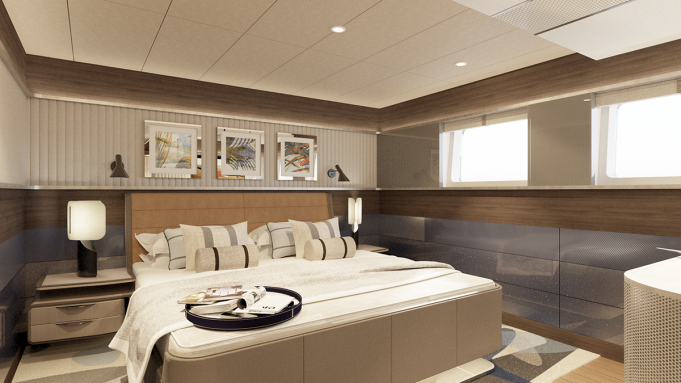Bannenberg & Rowell Design ได้พิสูจน์ให้เห็นว่าคุณไม่จำเป็นต้องสร้างตัวเรือใหม่ทั้งหมดเพื่อโดดเด่น
สตูดิโอของอังกฤษได้เปิดตัวเรือยอทช์ซูเปอร์ยอทช์ใหม่ที่โดดเด่น ซึ่งสร้างขึ้นจากตัวเรือที่แข็งแรงโดย Ares Shipyard ในอันตัลยา ประเทศตุรกี ตัวเรือได้รับการพิสูจน์แล้วในทะเลลึก โดยทำหน้าที่เป็นศูนย์กลางที่แข็งแรงของเรือลาดตระเวนที่ปกป้องชายฝั่ง (Ares มีเรือลาดตระเวนอย่างน้อยห้าชุด โดยมีเรือตั้งแต่สี่ถึงเจ็ดลำในแต่ละสาย)
“ตัวถังเรือลาดตระเวนประสิทธิภาพสูงฟังดูเหมือนเป็นรากฐานที่สมบูรณ์แบบสำหรับเรือยอทช์ 50 เมตรที่เร็ว ทะเยอทะยาน และเป็นไอคอน" สตูดิโอกล่าวในแถลงการณ์ที่แชร์เมื่อวันพฤหัสบดี
เรือยอทช์ลำใหม่ขนาด 164 ฟุตนี้ได้รับการตั้งชื่อว่า Spitfire เนื่องจากความแข็งแรงของมัน ผสมผสานกับภายนอกที่เพรียวบาง สปอร์ต และใช้งานได้จริงบางส่วนกับการตกแต่งภายในที่หรูหราและมีสิ่งอำนวยความสะดวกมากมาย Bannenberg & Rowell ดำเนินการออกแบบ ในขณะที่ Lateral Naval Architects ชาวอังกฤษเป็นผู้นำด้านวิศวกรรม
Spitfire มีน้ำหนักเบา แต่มีประสิทธิภาพและระยะทางที่ดีเยี่ยม ตามที่ Bannenberg & Rowell กล่าว สตูดิโอไม่ได้แชร์รายละเอียดใด ๆ เกี่ยวกับระบบขับเคลื่อน แต่บอกว่าเรือยอทช์ที่ “คล่องตัวเป็นพิเศษ” สามารถแล่นได้ด้วย “ไฟฟ้าและเงียบ” สามารถทำความเร็วได้ 22 นอต และครอบคลุมระยะทางได้ถึง 3,500 ไมล์ทะเล
Spitfire ออกแบบมาให้ทำงานเหมือนม้า แต่มีสิ่งอำนวยความสะดวกที่จำเป็นทั้งหมด Bannenberg & Rowell ยึดติดกับการตั้งชื่อแบบเดิม ๆ เพื่อเป็นการยกย่องรากฐานทางทหารของผู้มาใหม่ เลย์เอาต์ประกอบด้วยห้องพักคู่ (ห้องพักแขก) และห้องรับแขก (ห้องนั่งเล่น) ที่มีหลังคาเปิด รวมถึงสถานีปีนป่าย (หางเสือ) และพื้นที่สันทนาการ (ยิม) เจ้าของไม่เพียงแต่ได้รับห้องสวีทหรูเท่านั้น แต่ยังได้รับพื้นที่ส่วนตัวด้านหน้าพร้อมอ่างน้ำวน ไฮไลท์อื่น ๆ ของเรือยอทช์ ได้แก่ โรงภาพยนตร์กลางแจ้ง เครื่องย่าง และคลับชายหาดพร้อมระเบียงพับได้
Spitfire เป็นหนึ่งในผลงานที่เล็กกว่าและเรียบง่ายกว่าของ Bannenberg & Rowell สตูดิโอเคยเขียนแบบเรือยอทช์ขนาด 367 ฟุตที่มีโรงภาพยนตร์สองแห่ง อ่างน้ำวนสองแห่ง ศูนย์สุขภาพขนาดใหญ่ สระว่ายน้ำขนาด 33 ฟุต สถานีดีเจ และบาร์แจ๊สอีกด้วย Bannenberg & Rowell กล่าวว่าเรือลำนี้จะถูกส่งมอบในปี 2026
จากบทความโดย Rachel Cormack

Bannenberg & Rowell Design
Bannenberg & Rowell Design just proved you don’t have to reinvent the wheel—or hull, in this case—to stand out.
The British studio has unveiled a striking new superyacht based on a robust hull by Ares Shipyard in Antalya, Turkey. The hull has already proven itself on the high seas, acting as the sturdy centerpiece of a patrol boat that protects the coastlines. (Ares has no less than five series of patrol boats, with between four and seven vessels in each line.)
“A high-performance patrol boat hull sounded like the perfect underpinnings for a fast, nimble, and iconic 50m yacht," the studio said in a statement shared on Thursday.
The new 164-footer, christened Spitfire on account of her grunt, pairs a sleek, sporty, and somewhat utilitarian exterior with a luxurious, amenity-plenty interior. Bannenberg & Rowell executed the design, while fellow British outfit Lateral Naval Architects spearheaded the engineering.
Spitfire is lightweight in construction but punchy in terms of performance and range, according to Bannenberg & Rowell. The studio didn’t share any details regarding the propulsion system but says the “super-nimble" yacht can cruise “electrically and silently," can hit 22 knots, and cover up to 3,500 nautical miles.
Spitfire is designed to run like a workhorse but offers all the requisite mod cons. Bannenberg & Rowell has stuck with the old naming conventions in a nod to the newcomer’s military roots. The layout includes buddy quarters (guest cabins) and a wardroom (salon) with an opening roof, as well as a scramble station (helm) and a fun store (gym). The owner doesn’t just get a lavish suite, but also a private, forward area with a Jacuzzi. Other highlights of the yacht include an outdoor cinema, a grill, and a beach club with fold-out terraces.
Spitfire is one of Bannenberg & Rowell’s smaller and more understated creations. The studio previously penned a 367-foot superyacht with two cinemas, two jacuzzis, a large wellness center, a 33-foot pool, a DJ station, and a jazz bar, for example. Bannenberg & Rowell says the vessel is due to be delivered in 2026.
From the article by Rachel Cormack

Bannenberg & Rowell Design








